I have previously posted about the relatively small heat loss from a slab on ground
But what if you have got in slab heating, or just want to minimise heat loss/gain from your house?
Before Construction
This sketch shows the placement of the insulation, if you can arrange for the builder to install it before construction.
The way this is installed is the insulation foam is installed inside the slab formwork.
A 40mm foam board with an R value of 1.0 will typically reduce the heat loss from the slab by 50%.
If you have a small builder or are having a custom home built this should be possible……some project builders however will probably be unwilling to do this installation.
After Construction
If you want to insulate after construction this detail is as effective as the previous method.
It works by using the soil as insulation.
Although soil is not a great insulator by stopping the heat escaping upwards 1m of soil will provide a R value around 1.
See Insulation for similar Posts
For Posts about Green Building see Sustainability

What about the conductivity of the soil underneath the slab. The conductivity and heat loss of the ground underneath the floor are larger for wetter soils than for drier ones. Common Soil Conductivity values are 0.7 for dry soil, 1.2 for average soil and 2 for wet soil. Larger conductivities can increase the heat loss of slab on ground floors significantly.
Generally I think that the long term average soil conductivity under a slab should be around 1. Most people are not going to lay the slab over a wet soil. Once the slab is laid the soil is going to gradually dry.
Brian
Since the r-value is so low, a lot of soil is needed to get R-10 or R-20. However if the soil can be “boxed in” around the edges it should provide a lot of r-value. By “boxed in” I mean that every thermal path should meet the target R-value; for instance if the target is R-20 it should be impossible to draw a path from the slab to the outdoors or deep earth without encountering 20′ of (dry-ish) soil, or R-20 of foam, or X feet of soil and (20-X) R’s in foam.
Interesting thoughts………….. but for my Australian readers
These R values are in American units and are much different to the R values you are familiar with,
This approach is more related to North American or North European winters (with months below 0 degree C) which are quite a bit different to Australian Conditions.
Brian
Interesting Article. I read few of yours on this blog. They are very informative. Thanks a lot for sharing.
I truly enjoy reading on this web site, it has got fantastic posts.